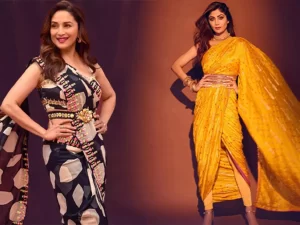All About the 3.5 to 9 yards of Saree Styles
There have been over 100+ saree styles that are draped from the early days. All states and villages had their own version of saree draping and of course, sarees were made different as per their regional art and weaving. Most sarees like White color with a blue or black panel border, and sometimes red were a part of sarees in ancient India.
History Fact of Saree Worn Then
Sari was worn by women centuries ago as a stripe of cloth to drape across the bodice. Initially, it was a piece of cotton or muslin in the normal gray fabric color. In fact, the sari was not worn in the way we see it today, before the British emperor and rule, the saree was worn to cover the lower torso and just worn bareless on the top torso without a saree blouse.
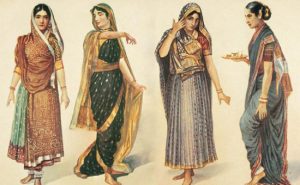
This was changed by British rule to cover the bosom by wearing a blouse and petticoat too. As we see a saree today worn with a saree blouse and petticoat. However, we see some old places and villages don’t wear a saree with a petticoat and drape it with a dhoti drape but in different ways. We will learn more about it in this article.
Saree Styles and Saree Patterns in Early Times
Saree Patterns were not very complicated or intricate but were woven in simple butti designs or simple color borders before the zari was introduced. Later Places like Maharashtra, and Kanchipuram, worked in zari borders and heavy silk sarees which sometimes had more colors and jacquard patterns too.
In some states printed sarees on cotton were more famous like Bandhani sarees in Gujarat. Some weaves were also introduced in sarees with more fabric variations like some ikat saree designs. However, printing and dyeing were done with organic colors like turmeric, carrots, beets, leaves, and natural substances.
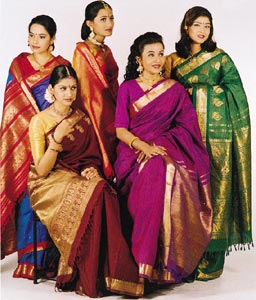
Wearing a saree in those early times was a simple drape at the lower torso, and to take the palla, no skirt drapes or palla pleats. It was more of a shorter-width fabric too just that was used as saree clothing.
Tribal Style Saree Draping of India
Even today we see these styles in villages and cultural places or cultural festivals.
Coorgi style saree worn by women of Karnataka where saree has pleats at back and the front palla is draped around like a sarong like a tube, and then taken from back to the right shoulder, and pinned at shoulder. Kanjivaram sarees were worn in the style.
Kunbi Style Saree is also still worn by tribal and village women in Goa. They worked in fields and hence wore saree above their ankles. A simple wrap around the waist and saree palla draped with a knot at the shoulder and let saree sit in sidha palla, covering the bodice and tucking in the waistline.

These two saree styles are just to show the idea that traditionally women wore short-length sarees like these. Or the Mekhele Chaddar saree of Assam has a different two-piece saree draped separately, one as a lower skirt and another as palla tucked in from the center waist.
Another style that evolved over time was the Kappalu saree of Andhra Pradesh and the Nauvari saree of Maharashtra. Kappalu saree style had pleats at front and back, and then a twisted palla which was wrapped two times over the waist and then over top to throw as a palla from the shoulder. While a Nauvari is a kasta saree with a dhoti look for warrior women of early times.
Saree Styles and Saree Designs in Present
The latest saree designs that we saw as time evolved were by more types of fabric weaves, silks, Kota, organza sarees, kanjivaram sarees, banarasi sarees, linen sarees, satin saree, georgette sarees, and more.
Techniques were brought in like hand-painted sarees like kalamkari art saree, ajrakh printing saree, and block printing sarees. Tie and dye bandhani-style sarees in the latest patterns. Ikkat weave designs sarees in modern motifs and geometry. Embroidered sarees in borders, panels, body, and palla are all styles that evolved from the older simple sarees.
Different Saree draping styles that re-fashioned with Time
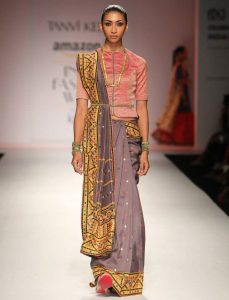
Siddha Palla Saree Draping
Worn in different pleats facing direction and also palla comes from back side to front. This style is worn in Parsi saree style, Rajasthani saree draping, and Gujarati saree draping styles.
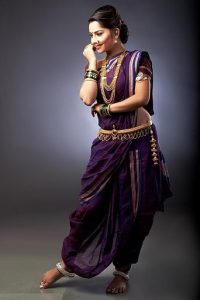
Marathi Saree Draping – Kashta sarees
Not much changed for nauvari saree, but a normal 6 yards saree was used to wear in kashta style saree. A normal saree with pleats in the opposite direction and just pick the middle-lower edge of the saree and drag it to the back side, tuck it in the waistline, creating a normal kasta. However, there are more ways of Maharashtrian saree draping apart from the nauvari saree draping style.
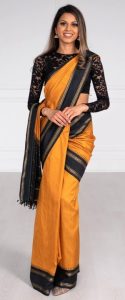
Nivi Style saree – Classic saree drape
The style has been here for centuries now one of the widest worn Indian saree styles in drapes, a normal saree is known as the Nivi style saree. Has been draped in any kind of saree with pleats on the shoulder or as an open palla style.
Modern Saree Styles and Modern Saree Drapes
The above-mentioned 3 styles are still worn and have been in fashion for a very long time. But some different saree types are also here today.
Saree has worn like a lehenga, with small pleats around the whole torso, with just palla as a drape. Or saree draped in pleats to make a lehenga out of the saree. These are some indo western saree styles that trend high today.
Saree gown styles, wearing saree with pleats in normal ways, while palla is tucked away inside waist as a draped gown look. Another way of it was taking a palla corner as a zigzag pleat drape on the front left shoulder and belted to cover the front side with a saree entirely.
Dhoti style saree draping, a variation of kasta saree or Marathi saree. The dhoti style drape can be done with a half saree that’s 4.5meters or a normal 5.5-meter saree. Wearing saree from the pleats on width and tucked in leggings and not a petticoat. Then take a saree from the back side, make pleats at the back and secure it there. Now again make the pallu pleats and drape them on the left shoulder.
Pant style saree – can be worn with palazzo pants or leggings or jeans. Drape the whole saree in pleats and tuck the left mid side on the pants. Take the rest of the saree which is palla from the back to the other side in front. Make pleats and pin at the shoulder, One side of the pants is visible in this saree draping style.
The Stylish blouse or top saree styles, where modern saree draping is done on tops, bustiers, blazers, or crop tops instead of blouses. See more modern saree draping styles to learn in the blog post. Also, buy these amazing sarees online only from G3fashion.



